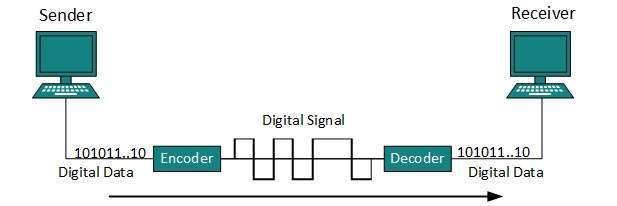Components of Digital Communication System
Subject: Science

Overview
Digital communication involves a source, input transducer, encoder, modulator, channel, demodulator, decoder, output transducer, and output signal. Analogue communication is analog, while digital communication is digital. The transmitted signal is analog but not programmable. Coding techniques can detect errors, and FDM and TDM are used for multiplexing.
Elements of Digital Communication
- Source
One possible source for signal transmission is an analog signal, such as sound waves.
- Input Transducer
The signals that are received are transformed into an electrical signal by the input transducer. A microphone, for instance, transforms sound into energy.
- Encoder
The encoder reduces the number of bits in the data. This procedure will aid in making efficient use of the bandwidth, or available frequency range.
- Modulator
The modulator will modulate the data before transporting it on the carrier. Once these signals have been converted to analog signals, they are sent into the medium, or channel, for transmission. A digital sequence is converted into analog signals for transmission through various channels or media.
- Channel
After leaving the transmitter, the analog signals need a channel or medium to go to the receiver.
- Demodulator
This is the initial phase from the receiver's perspective. The signal that the receiver has received is demodulated.
- Decoder
The decoder re-digitizes the demodulated signals that it has received. It eliminates any potential mistakes in the final output signals.
- Output Transducer
The original physical signal that was delivered through the source is transformed back into the decoded signals. It converts electrical impulses into tangible results. A speaker, for instance, transforms current into sound.
- Output Signal
The end outcome of the entire signal transmission procedure is explained. For instance, sound waves are the result of sending sound waves from a source for transmission.
Differences Between Analogue Communication and Digital Communication
| Analogue Communication | Digital Communication |
| The transmitted modulated signal is analog in nature. | The transmitted signal is digital, i.e., a train of digital pulses. |
| It is not possible to code. | Coding techniques can be used to detect and correct the errors. |
| FDM is used for multiplexing. | TDM is for multiplexing. |
| Not suitable for transmission of secret information in military applications. | Due to coding techniques, it is suitable for military applications. |
Things to remember
- An input transducer, an encoder, a modulator, a channel, a demodulator, an output transducer, and an output signal are all parts of digital communication that change an analog signal into an electrical signal.
- An encoder reduces the number of bits in the data before converting analog signals into digital signals and sending them through a channel.
- The demodulator re-digitizes the demodulated signals, while the output transducer converts the original physical signal back into the decoded signals.
- Digital communication is not coding but can be used for multiplexing. It is suitable for military applications but not for secret information transmission.
© 2021 Saralmind. All Rights Reserved.


 Login with google
Login with google